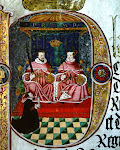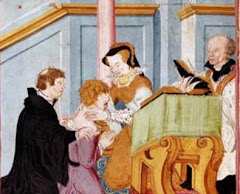
1. Mary did not wish to be anointed with the holy oils consecrated by Edwardian ministers – men whose views she deemed as heretical. So she had the bishop of Arras in Brussels send ‘untainted’ oils. The bishop sent three lots though apologised about the rather plain vessels encasing them. Had I longer than three weeks to send them I would have commissioned some nicer cases, he told the Imperial ambassador Simon Renard.

2. The archbishop of Canterbury did not preside over the coronation ceremony, as was customary. Instead Stephen Gardiner, bishop of Winchester took lead. The reason? The current archbishop was her loathed enemy, Thomas Cranmer, then imprisoned in the Tower. Ally Gardiner was a safer bet.

3. Mary’s coronation was naturally unique given she was first woman crowned as monarch in her own right. So during the ceremony she held, as Gianfrancesco Commendone records, ‘in her hands two Sceptres; the one of the King, the other bearing a dove which, by custom, is given to the Queen [queen consorts]’. It would have been the same dove-topped sceptre her mother, Katherine of Aragon, held during her coronation alongside husband Henry VIII in 1509.

4. Mary’s crown was carried in the abbey by the aged Thomas Howard, 3rd duke of Norfolk (who had recently been released from the Tower). His steward was his grandson and heir, Thomas. The duke’s estranged wife, Elizabeth, helped carry the train of Mary’s magnificent coronation robes.

5. Mary progressed to the abbey under a ‘rich canapye of Bawdkyn’ carried ‘by the barouns of the v ports’ (i.e. the Barons of the Cinque Ports). This was completely in line with tradition and was identical to the one used in her father’s coronation in 1509.

6. In order to ensure the entire congregation could witness Mary’s crowning, a platform was erected within the abbey. It was twenty steps high, and Mary had to ascend a further ten steps to get to the throne situated on its own dais.

7. To the abbey Mary wore ‘her parlement robes of crymsyn veluit’ (as traditional) which covered her ‘gown of blew velvett’. During the ceremony she changed and wore a ‘mayntell of Crymsyn velvit bordered with Ermyn with buttons and tasiles of sylke and golde’.

8. Mary was the second (not the first as sometimes stated) English monarch to be crowned with three crowns. They included St Edward the Confessor’s crown, the imperial crown commissioned by Henry VIII, and a crown ‘purposlie made for her grace’. The first monarch crowned in such a manner was her predecessor, and brother, Edward VI.

9. The queen’s champion – the man whose task it was to boldly announce he would fight any man who refused to recognise Mary as the sovereign– was Sir Edmund Dymoke. He appeared during the coronation banquet on horseback dressed in full armour and flung down his gauntlet daring anyone to accept the challenge. In gratitude Mary gave him her gold drinking cup filled with wine.

10. 7,112 dishes were served at Mary’s coronation banquet. The lady herself was served over 312 dishes. Of these numerous dishes around 4,900 were listed in records as ‘waste’.
But before you shake your head at such excess and greed, it seems the remaining dishes were distributed to Londoners. And Londoners appreciated the freebies. There was a desperate scramble for the food (as there was for the bits of carpet Mary walked on and the rails constructed to keep the crowd in line). The kitchens were soon emptied. But not just of food. The celebratory mood caught fire and soon even bits of furniture were ripped from the kitchens. Such vandalising and looting in London! Thank goodness we live in more civilised times...

For more on the coronation see,
John Edwards, Mary I: England’s Catholic Queen (London and New Haven, Yale University Press, 2011), pp. 123-34.
Alice Hunt, ‘’What art thou, thou idol ceremony?’: Tudor coronations and literary representations, 1509-1559’, PhD thesis, Birbeck, University of London, 2005.
Alexander Samson, ‘The marriage of Philip of Habsburg and Mary Tudor and anti-Spanish sentiment in England: political economies and culture 1553-1557’, PhD thesis, Queen Mary, University of London, 1999), pp. 54-67.



